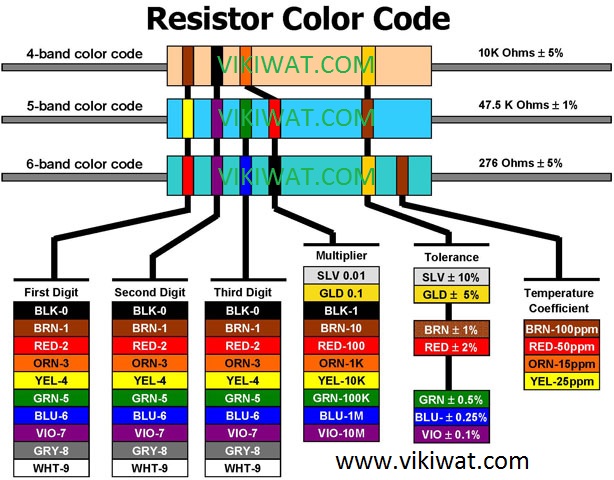fig.1
The color code of resistors is presented by some colored bands on the resistor, by which the resistance, the tolerance and the temperature coefficient of the specific resistor are coded. A color code may be used on diodes, transistors and capacitors as well. The International standard that regulates the placement of color codes is IEC 60062. Color codes were used for the first time in 1920, because the lines can be printed cheaply and easily, thus reducing the final cost of the product, marking its main features. By Figure 1, which is animated, you can decrypt your resistor in a simple and easy way. From the indication "Type of marking", select the number of bands that you see on the resistor you want to decrypt. For example, if your first band is yellow, choose yellow from the right column. When you click on it, as the figure is interactive, the first band turns yellow and the arrow moves automatically to the second one.
If the second one is blue, press the blue color on the right and the band on the resistors in the image will turn blue and the arrow will move to the third band, and so on. Meanwhile in the fields below the resistor you can see "Resistance" in ohms and "tolerance" as a percentage, of your resistor. Since the sixth band indicates the temperature coefficient, when you select 6 bands – a third window will appear showing how the resistance of the resistor will change depending on each temperature degree. This change is small and therefore it is indicated by ppm (parts per million). It's really quite small and dimensionless and for comparison, it corresponds to a drop of water in a 50 liter container or to 32 seconds in a year.
For more clarity, let's examine Figure 2. It shows three resistors one below the other, respectively with four, five or six color bands. The resistors in the example have colored bands which are decoded on the right, on the "conductor" of the resistor. The numbers corresponding to the colors are shown below, in the form of colored columns. The first three columns are the first three significant digits (discharges) of the value of the resistor’s resistance. The fourth column is the multiplier by which the resulting number is multiplied, the fifth column determines the accuracy of the resistor in percentage and the sixth – the temperature coefficient, which we mentioned above

fig.2














